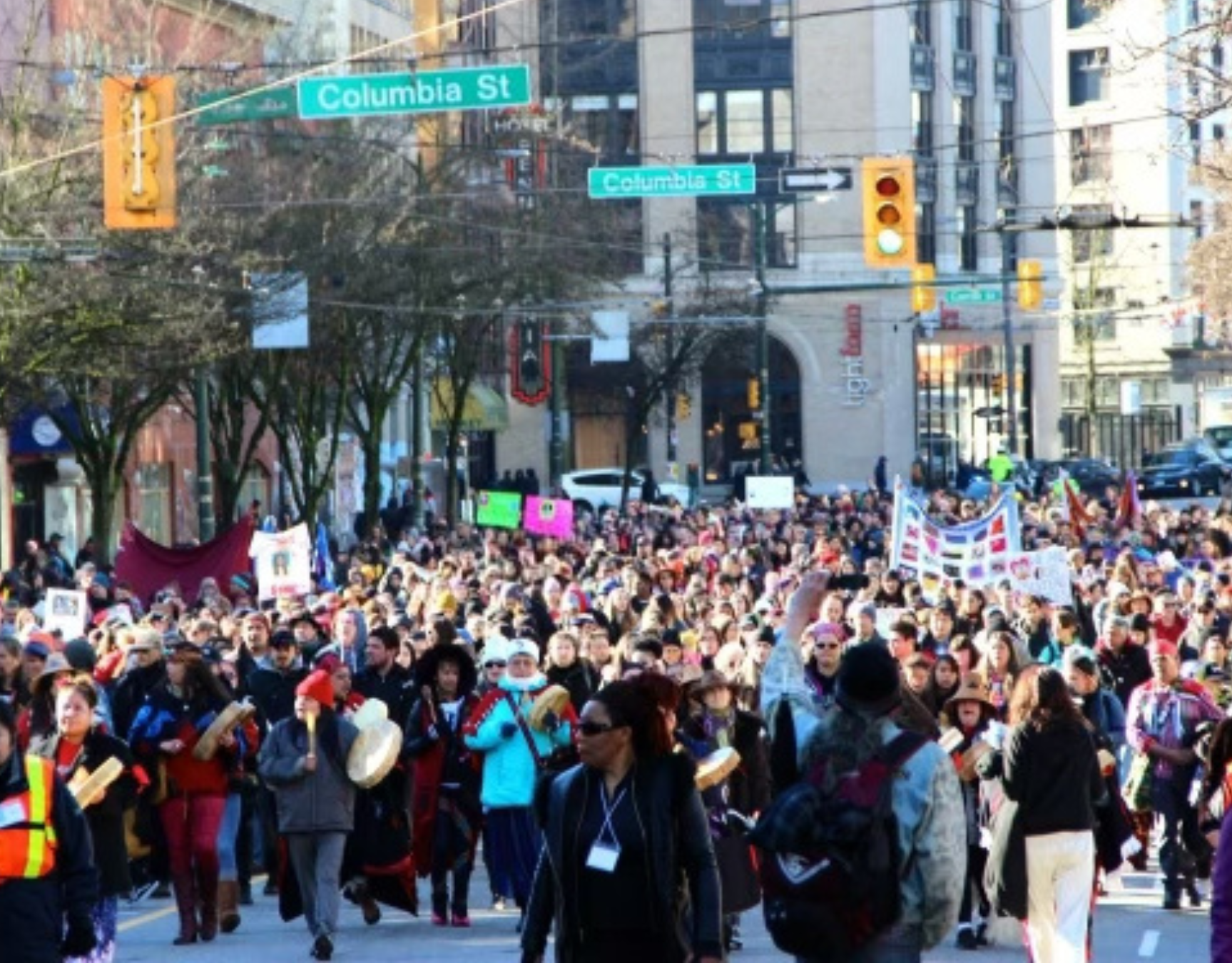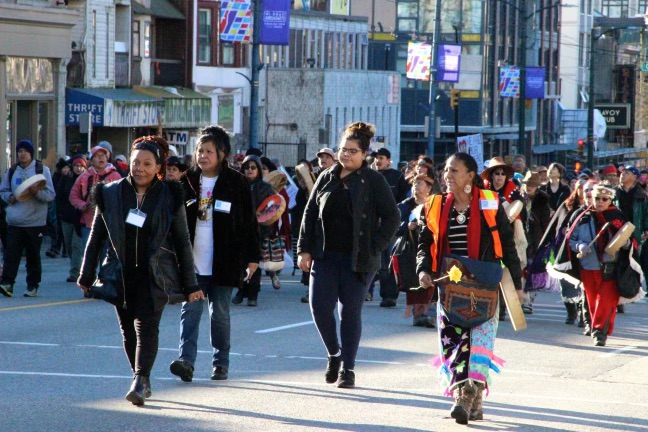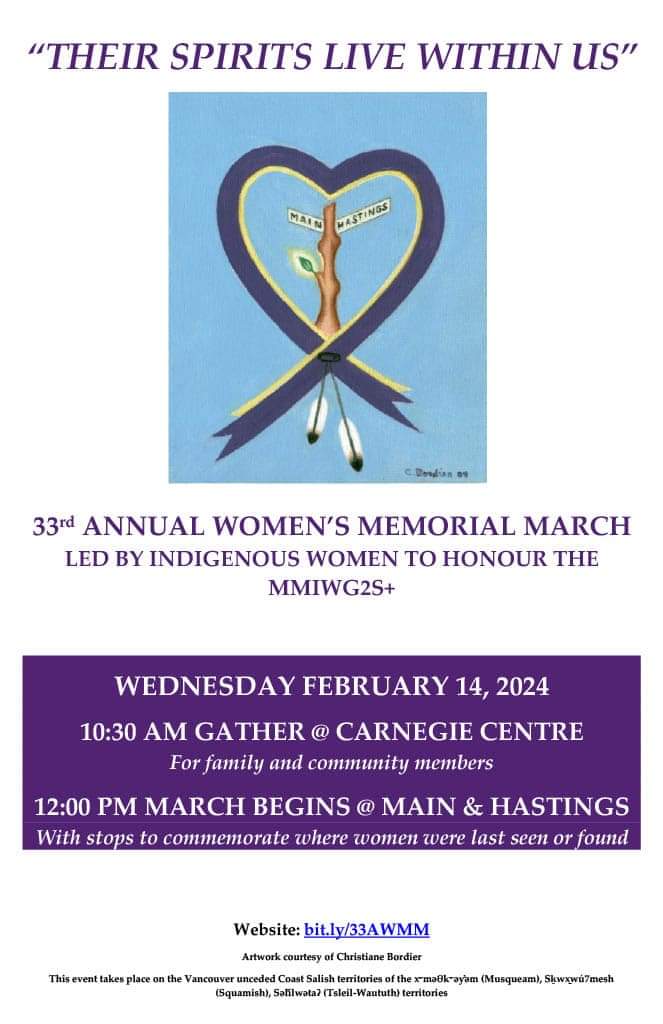
Why I March on February 14th at the Women’s Memorial March by Angela Marie MacDougall, Executive Director of BWSS
Trigger Warning: The following passage contains descriptions of violence, abuse, and exploitation. Reader discretion is advised.
It has taken a while to write this, and even now, as the words hit the electronic page, it is uncertain if this is the time or the format to share some of the reasons why I march on February 14th at the Women’s Memorial March. Ultimately, it is about my own experience as a bi-racial Black girl growing up in Metro Vancouver, where all the memories from childhood and youth are shared by a day-to-day experience and witnessing of misogynist and racist violence against women and girls.
The violence experienced by the mothers from the fathers of my grade school and high school mates. The stories shared by my friends of incest by their fathers and/or brothers. The casual victim blaming infused in the Monday morning stories of weekend gang rapes committed by classmates against classmates, casually and laughingly shared at the smoke pit at my high school. Or witnessing my step-father abuse my own mother and later my experience of sexual exploitation as a fifteen year old ‘runaway.’ I developed a profound sensitivity to how misogynist violence infused with race and class was…is widespread and regular occurring. Yet rendered invisible within a toxic cloud of victim blaming.

Nearing the end of the experience as a sexual exploited youth, navigating the extreme potential for violence and lethal violence as a continuous practice united us as sex workers with genuine camaraderie. It was jarring when Elaine Allenbach went missing. My memory tells me it was raining the night I learned that Elaine had gone missing and a few days later, two Vancouver Police detectives approached me while I stood at the corner of Helmcken and Seymour streets in the Vancouver neighbourhood, now known as Yaletown, to ask me about the last time I had seen her. I shared with them what I remembered and what I knew about her regulars. That was March 1986, and 38 years later, and Elaine is still missing, presumed a victim of femicide.
Transitioning into “square” life (https://pubmed.ncbi.nlm.nih.gov/26577882/) and continuing my formal education, by 1988, I was studying Counselling Psychology and doing a practicum with child and family service organization and facilitating groups for sexually exploited youth. That was an extraordinary peer facilitation experience that was transformative in so many ways.
At the time, I reconnected with my childhood friend Patricia Ann MacPherson, one of my dearest friends who I had known since grade six. We were both young mothers and spent a weekend together catching up and having fun. I hold fond memories of that weekend because it was the last time, I would see her alive.
On December 9, 1988, Trish was killed while on a date with a man we both knew. It is horrifying to think about what she went through during the last moments of her life. I attend the trial of the man who killed her but really…so much of learning about her death became a dissociated memory fragment that is always recalled with tears. Part of that grief and rage journey of reckoning with the violent way Patricia Ann MacPherson died and that she had left this world became a politicizing moment dramatically changing the trajectory of my personal and professional life.

Inspired by the writing of Judith Herman and her brilliant book Trauma and Recover: The Aftermath of Violence – From Domestic Violence to Political Terror in the 1990’s, professional counselling and feminist organizing spaces started to integrate a trauma-informed approach to understanding social problems and how people can heal. Delayed by the Canadian context by the time I got access to Kimberlé Crenshaw’s influential writing Mapping the Margins: Intersectionality, Identity Politics, and Violence against Women of Color, I was highly motivated to apply these ideas that validated the lived experiences of so many around me and myself
In 1994, I was employed at a women-serving organization located in the Downtown Eastside neighbourhood in Vancouver doing frontline work supporting women navigating the impacts of colonization, child welfare, residential school, incest, racialized and gender violence, sexual assault, intimate partner violence, police brutality, and homelessness. Women were going missing…some women were being found murdered and of the missing and murdered women, I had met either through work or through my lived experience.
I heard about a women’s march that was held on February 14th to honour women who had gone missing or who were murdered and that there was a committee of people who organized the march…so I joined. The committee became a way to be part of change. And participating in the march was a way to honour my friends and women I knew, while making visible the racialized gender violence that has been baked into the making of Canada as a nation grinding down in the lives of women and girls and with attention to the violence experienced by Indigenous and Black women.

And the violence didn’t stop instead and the result of the broader community that ignored women who were pushed to the margins of public concern and during the 1990’s there were at least three serial killers abducting and killing women mostly from the Downtown Eastside in Vancouver.
My friend Tracy Olajide was killed, and she was found in mountains near Mission in the Fraser Valley in 1995. I hadn’t seen Tracy for a few years and remember her beautiful smile and always quick to crack a joke and make people laugh. It is still shocking to know that she had passed. I remain in contact with her mother and watch the brilliance of her beautiful and very accomplished son.
I met Mary Lidguerre in 1995, tall and beautiful, warm, and kind, thoughtful, and considerate. The last time, I saw Mary, we shared some jokes and some laughs and that is my memory of Mary who went missing that same year and was discovered deceased on Mount Seymour in August 1996.
Both Tracy and Mary are linked to the Hemlock Valley Murders. Many people may not recall the Hemlock Valley Murders (https://youtu.be/Sfuqkaodkgk?si=NZyTekr3Hlha94rU).
And we kept marching, every year on February 14th…


Through the 1990’s to the 2000s and to 2010s there have been trials and inquiries and trials and inquiries, and the entire time February 14th Women’s Memorial March in Downtown Eastside Vancouver continues to honour the lives of our beloved sisters and to highlight the systemic nature of the killings and deaths, to visible the intersections of gender, race, poverty all the result of colonialism.
I march for Elaine, for Trish, for Tracy, for Mary, for Kathleen Watley, for Janet Pelletier, for Tina Fontaine, for Stephanie Forster, for Cindy Gladue, for the hundreds of women, girls and gender diverse people who have been killed in the Downtown Eastside and neighbourhoods just like the downtown Eastside across the territories and all the girls and women who reach out to BWSS seeking safety from violence.
Their spirit lives within us…





